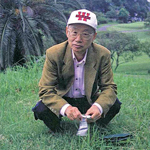JUST PUBLISHED
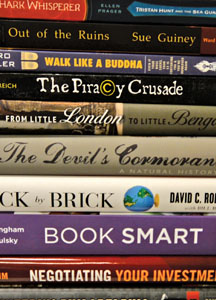
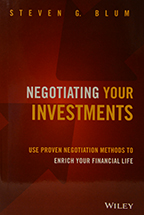 Steven G. Blum ’81
Steven G. Blum ’81
Negotiating Your Investments
Wiley, 2014
Experienced negotiating strategist Blum reveals how to apply negotiating knowledge to the world of individual investing in this detailed guide. With expert insights into all the stages of a successful negotiation, this book teaches readers how to prepare for and conduct important financial discussions with an eye toward getting the best possible outcome with advisors, fund managers, banks, lawyers, and others. Clear, concrete advice describes how to influence the other side, avoid being taken advantage of, and direct the conversation to your advantage. Topics include: the elements of negotiation—identifying goals, interests, commitments, alternatives, and power; the four phases of negotiation—preparation, information exchange, bargaining, and closing and commitment; asymmetric information, conflicts of interest, professionalism, and whom to trust; and investment vehicles and the economic science that lies behind wise investing.
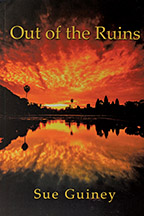 Sue Guiney ’77
Sue Guiney ’77
Out of the Ruins
Ward Wood Publishing, 2014
In her gripping second novel, Guiney writes about women’s health issues and the sex trade in Cambodia, based in part on research done in the city of Siem Reap where she teaches each year. The story begins with a Cambodian doctor who is frustrated that the poor women in his country are dying needlessly. He reaches out to friends to help him create a new clinic for the local villages around Siem Reap’s world-famous temples. An Irishman, Dr. Diarmuid, arrives with his English assistant, Dr. Gemma, and a Canadian administrator, Mr. Fred. Together they establish a place where poor women of Cambodia can find the basic care that is taken for granted in other parts of the world. A young and ambitious Cambodian nurse acts as an interpreter and a connection to the local community, but her idealized view of Western medicine becomes seriously challenged. Though the doctors are all too eager to help, they must deal with their own personal demons.
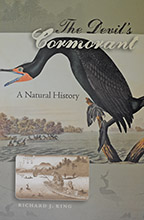 Richard J. King MALS ’03
Richard J. King MALS ’03
The Devil’s Cormorant
University of New Hampshire Press, 2013
King takes the reader back in time and around the world to uncover the history, nature, and ecology of the cormorant, one of the world’s most misunderstood waterfowl. Evolution has crafted the only creature on Earth that can migrate the length of a continent, dive and hunt deep underwater, walk on land, climb up cliff faces, feed on thousands of different species, and live beside both fresh and salt water in a vast range of temperatures and altitudes. Over time the bird has served as a symbol of gluttony, greed, bad luck, and evil in human history, myth, and literature. King covers a range of individuals and their relationship to this family of birds and reveals how they have been prized as a source of mineral wealth in Peru, hunted to extinction in the Arctic, trained by the Japanese to catch fish, and despised and gunned down by sport and commercial fishermen for some 500 years, particularly in Europe and North America.
 Ellen Prager ’84
Ellen Prager ’84
The Shark Whisperer: Tristan Hunt and the Sea Guardians, Book 1
Scarletta Junior Readers, 2014
Marine scientist Prager incorporates her knowledge of Earth and ocean science issues into this entertaining young adult novel about Tristan Hunt, who is invited to an ocean-themed summer camp in the Florida Keys. There he learns that he can talk to sharks and that the other young teen campers possess special and valuable talents in the ocean. When the camp director receives a distress call from ocean animals, Tristan and his new friends become part of a daring rescue in the Bahamas. They enlist the aid of sharks, dolphins, an octopus, and seabirds in an effort to thwart an evil billionaire who harvests shark fins.
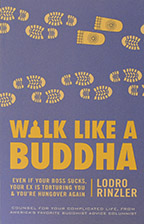 Lodro Rinzler ’05
Lodro Rinzler ’05
Walk Like a Buddha
Shambhala, 2013
Rinzler became a regular meditation practitioner at an early age, went to a Buddhist monastery at age 17, and started a meditation group at Wesleyan that became Buddhist House. “While I was in college,” he writes, “I found myself in many conversations with my peers around basic Buddhist ideas and how they came to bear on my life … how they were relevant to my existence.” Based on Rinzler’s popular advice column which appears online in The Huffington Post and The Good Men Project, this guide for the spiritually minded uses Buddhist teachings to answer questions related to everyday life, such as going out, relationships, work, and social action. It considers such questions as: How can I be the person I want to be when I’m stuck in a job I hate? How is it possible to stay present in an era of nearly constant distractions? Is there anything non-Buddhist about finding a partner online? The book offers advice that can be applied to dilemmas that tend to arise for anyone making an attempt to live with honesty, wisdom, and compassion in a challenging world.
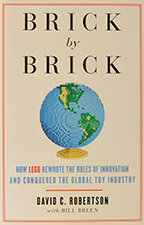 David Robertson ’81 and Bill Breen
David Robertson ’81 and Bill Breen
Brick by Brick: How LEGO Rewrote the Rules of Innovation and Conquered the Toy Industry
Crown Business, 2013
This book traces how the LEGO company grew from a small woodworking shop in a tiny Danish town to become one of the most beloved global brands of all time. In 2003, the company was heading toward bankruptcy but a new management was able to steer things in the right direction, transforming the business into one of the world’s most profitable, fastest-growing companies. As the appointed LEGO Professor at the Institute of Management Development IMD in Lausanne, Switzerland, in 2008, Robertson had firsthand access to the insular company and its customers. He toured the factories that produce billions of bricks each year, watched designers dream up new toys, and interviewed the company’s top executives. Robertson includes candid insights and critiques from the company’s leaders and employees. He shares lessons that will guide leaders in their own efforts to improve their organizations’ attempts at innovation.
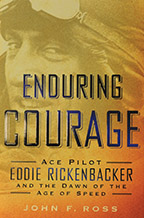 John F. Ross ’81
John F. Ross ’81
Enduring Courage: Ace Pilot Eddie Rickenbacker and the Dawn of the Age of Speed
St. Martin’s Press, 2014
Ross tells the legendary story of Eddie Rickenbacker, whose fascinating, often heroic life coincided with the beginning of America’s obsession with speed, hastened by the arrival of the car and the airplane. Rickenbacker was an innovator on the racetrack, a skilled aerial dualist and squadron commander, and founder of Eastern Air Lines. As the son of poor, German-speaking Swiss immigrants in Columbus, Ohio, he overcame his father’s violent death, a debilitating handicap, and, later, accusations of being a German spy, to become the American military ace of aces in World War I and a Medal of Honor recipient. During World War II, he lived through two plane crashes and showed a war-weary nation what it took to survive against incredible odds when he and seven others endured a harrowing three-week ordeal adrift without food or water in the Pacific.
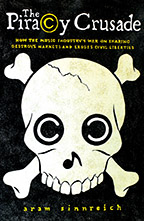 Aram Sinnreich ’94
Aram Sinnreich ’94
The Piracy Crusade
University of Massachusetts Press, 2013
This study argues that a handful of companies that dominate the film, software, and music industries act as crusaders who are waging a destructive war against digital technology innovators and so-called “pirates.” Attempting to shut down peer-to-peer sharing and unlicensed streaming of media, the industries have used excessive force against users in order to stop copyright infringement. Sinnreich writes that the resulting laws and policies have only succeeded in hurting free speech and privacy while failing to curb the trend in pirating. The book begins by charting a social history of the music industry and examining its relationship with 20th-century technology. Sinnreich then looks at P2P, or peer-to-peer, file sharing in comparison to traditional music economics and recent trends in sales.
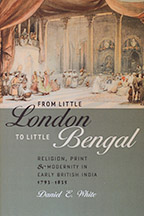 Daniel E. White ’91
Daniel E. White ’91
From Little London to Little Bengal
The Johns Hopkins University Press, 2013
White examines the traffic in culture between Britain and India during the Romantic period. In the early part of the 19th century, part of Calcutta could be called “Little London,” while in London itself an Indianized community of returned expatriates was emerging as “Little Bengal.” Circling between the two, this study considers British and Indian literary, religious, and historical sources alongside newspapers, panoramas, religious festivals, idols, and museum exhibitions. White focuses on global metaphors of circulation and mobility, communication and exchange, commerce and conquest, and he follows the movements of people, ideas, books, art, and artifacts initiated by writers, publishers, educators, missionaries, travelers, and reformers.
 Domenic Vitiello ’95
Domenic Vitiello ’95
Engineering Philadelphia: The Sellers Family and the Industrial Metropolis
Cornell University Press, 2013
Across more than two centuries, the Sellers family of Philadelphia were prominent as manufacturers, engineers, social reformers, and urban and suburban developers, and they turned the city into an industrial and cultural center. Vitiello tells the influential family’s story, situating their experiences in the context of industrialization and urbanization in America from the colonial era through World War II. The reader learns how family and business networks shaped the social, financial, and technological processes of industrial capitalism. The family and their network influenced corporate and federal technology policy, manufacturing practice, infrastructure and building construction, and metropolitan development, while their declining fortunes contributed to the deindustrialization of Philadelphia—and the nation—over the course of the 20th century.
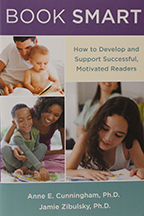 Jamie Zibulsky ’02 and
Jamie Zibulsky ’02 and
Anne E. Cunningham
Book Smart: How to Develop and Support Successful, Motivated Readers
Oxford University Press, 2013
Reading together may serve as a way for discussing the varied yet interconnected language and literacy skills that jumpstart the career of a successful and independent reader. This how-to guide is rich with stories, lessons, activities, and ideas aimed at addressing the broad range of interpersonal, social, emotional, and motivational skills that must be fostered in young children. The early chapters will help prepare a child to get ready for school and ready to read, and the later chapters will help foster a child’s lifelong love of reading. The authors provide tips for building a special bond with children through reading together. The book also addresses oral language and emergent literacy skills, the child’s early writing attempts, story comprehension, general knowledge development, and social-emotional growth.

